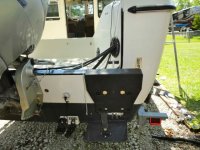About 99% of the C Dory transducers are going to be transom mount. One reason is that most boats are trailered, and a transducer sticking thru the hull is not a great idea.--;plus it can cause turbulence in front of the motor.
Any thru hull in the c Dory should be either thru solid glass, or the core removed, for and inch around the hole, and this filled with thickened epoxy. This is to avoid compressing the core, as well as avoiding water intrusion into the core.
For the deeper (500 feet is in that category), I would suggest 50 Khz. Also you want at least 500 watts, 1000 watts is preferable.
CHIRP Even in the 120 to 200 Khz range can work down to around 600 feet.
Mounting a transom transducer is important. First you don't want to compromise the core of the transom, and you want to be able to adjust the transducer, if necessary, without drilling a bunch of holes.
I use a 3/4" thick piece of Starboard. ( HDPE ) I drill 2 holes in the block with a drill press, and countersink the surface for the 2 screws. I use this as a template to drill the two pilot holes in the transom--Then over drill the hole for the screw in the transom. I use a dremel tool to cut away the core around the hole by about 1/4 inch. Fill the entire area, with thickened epoxy (brush the core with unthickened epoxy first. (I use the same mix, put in the catalyzed epoxy, then thicken with cabosil and medium density filler. Let this kick off and then drill the pilot hole for the screws. I also dovetail cut the back of the starboard, and sand any paint off the area of the point of attachment of the HDPE block, smear with 5200 and set the screws. Then screw the transducer into the block.
Below are two transducers screwed into one HDPE block. One is conventional 50/200 Khz, the other is DownScan CHIRP--no interference.

There are also some kits sold with "magic" adhesive and blocks--never tried them--but I like belt and suspender system..

